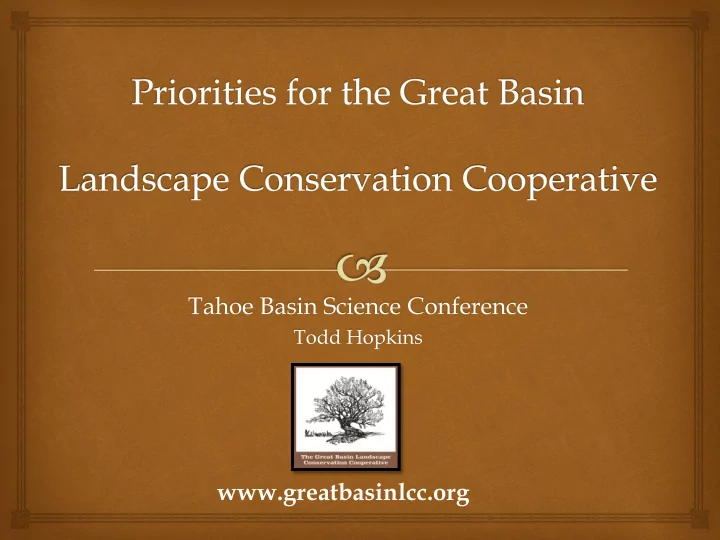

Tahoe Basin Science Conference Todd Hopkins www.greatbasinlcc.org
Secretarial Order No. 3289 “The conservation community must establish increasingly effective and coordinated mechanisms for science development, the sharing and transfer of science and related information, and the creation of innovative and effective science-based conservation tools, all predicated upon on collaboratively developed priorities.” - Secretary Salazar, September 2009 2
What are LCCs? Public-private partnerships composed of states, tribes, federal agencies, non-governmental organizations, universities and others. Role: to leverage funding, staff and resources; to develop common goals; to develop tools and strategies to inform landscape-scale planning and management decisions; to link science to management; and to facilitate information exchange among partners. 3
4
Why A Landscape Approach? Management Characteristics Traditional Practice Landscape Approach Project Focus Landscape Focus Program/Functional Direction Integrated Direction Across Programs Unit Decision Making Cross-Jurisdictional Decision Making Unit Priorities Collaborative Partnership Priorities Program Accomplishments Integrated Accomplishments Across programs with Partnerships Tend to Authorize Uses and Mitigate Ecological Values and Use Ecological Values Authorizations Considered Equally Ecological Component (individual Ecological Function and Service species) Agency Funding Partnership Leveraged Funding 5
LCC Functions Forum for strategic response Convene partners Coordinate activities across partners Integrate activities under a regional strategy for adaptation Prioritize science needs and convey them to the Climate Science Centers (CSC) Apply CSC products in adaptive management partnerships 6
The Great Basin “ An Army of Caterpillar's marching towards Mexico” Clarence Dutton 19 th century geologist America’s largest desert: 185,000 sq mi • • Wildfire cycle was 20-100 years • Half of it gets <12 inches precip/year • Topography: Mt Whitney 14,505 ft to Badwater Basin -282 ft Population: 3.1 Million • 7
8
Great Basin LCC Steering Committee Nevada Mining Association Bureau of Land Management Great Basin Cooperative Ecosystem Studies Unit Natural Resources Conservation Service Partnership for National Trails, Public Lands Council Great Basin Research & Management Partnership, Paiute Indian Tribe of Utah California Department of Fish and Game US Geological Survey State of Utah PacifiCorp US Forest Service Eastern Nevada Landscape Coalition, Great Basin Environmental Program Duckwater Shoshone Tribe, Farm Service Agency The Nature Conservancy US Fish and Wildlife Service Lahontan Audubon Society Great Basin Water Network Nevada Association of Counties 9 Nevada Department of Wildlife
Great Basin Cooperative Mission To enhance understanding of the effects of changing climate and other natural and human impacts across the region and promote the coordination of science-based actions to enable human and natural communities to respond and adapt to those conditions . Goals: Provide leadership Focus science and management Enhance collaboration Promote communication an d education. 10 Ms. Linda Kelly (center) GBLCC Coordinator
Great Basin Land Ownership 72% Federal Management Acres Percentage Tribal 1,382,365 0.95% Bureau of Land Management 78,499,886 53.93% Bureau of Reclamation 38,321 0.03% Department of Defense 3,570,405 2.45% Department of Energy 670,169 0.46% Local 358,390 0.25% Federal (Miscellaneous) 132,831 0.09% National Park Service 919,144 0.63% Private 32,385,413 22.25% State 3,716,394 2.55% Unknown 7,296 0.01% U.S. Forest Service 20,343,170 13.98% U.S. Forest Service / BLM 191,902 0.13% U.S. Fish and Wildlife Service 1,319,074 0.91% Water 2,011,978 1.38% Total 145,546,736 100.00%
Climate Science Centers USGS CSC LCC Great Basin Research & provides provides science for regional Management Partnership applicatio science n needs assessmen t Utah Partners for Conservation & Great Basin Cooperative Development Ecosystem Studies Unit GB LCC Coordinate & Provide support to Nevada Partners for landscape scale Conservation & Great Basin efforts to leverage Development Environmental Program resources Eastern Nevada The Nature Conservancy Landscape Coalition Sub – assessments & decision support tools Regional Efforts: Federal Agencies Great Basin Native Plant Selection & Increase Project & JFS BLM, FWS, USGS, FS, NRCS, BOR, SageSTEP Project DOD …… Tribes , NGO’s, Universities, State Agencies Public
Climate Science Centers CSCs will deliver climate-change science to Landscape Conservation Cooperatives, including physical and biological research, ecological forecasting, and multi-scale modeling. 13
2012 Priorities Set by the Great Basin LCC Steering Committee Coordinate science/conservation of sage-dependent species and habitats. Facilitate information transfer of cheatgrass die- off study outcomes. Build upon the Rapid “The Greater Sage Grouse, Ecoregional Assessments an icon of the American including alternative future West, depends on healthy scenarios. landscapes.” 14
Where the funding has gone Source: Defenders of Wildlife, 4/2012, Noah Matson’s Blog 15
greatbasinlcc.org Linda Kelly , Coordinator 775-861-6463 ljkelly@blm.gov Todd Hopkins , Science Coordinator 775-861-6492 todd_hopkins@fws.gov Matt Germino , Research Ecologist (208) 426-3353 mgermino@usgs.gov 16
Recommend
More recommend